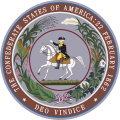| Davis Guards Medal | |
|---|---|
 Obverse and reverse of the medal | |
| Type | Campaign medal |
| Awarded for | The defense of Sabine Pass, Texas |
| Country | |
| Presented by | the citizens of Houston |
| Eligibility | Members of Company F (Davis Guards), 1st (Cook's) Texas Heavy Artillery Regiment; Second Lieutenant N. W. Smith, Engineer Corps; and Assistant Surgeon George H. Bailey |
| Campaigns | Joint Federal Expedition to Sabine Pass, Texas (September 7–8, 1863) |
| Established | 1863 |
The Davis Guards Medal was a military award presented by the citizens of Houston to each of the participants a few weeks after the battle of Sabine Pass (September 8, 1863). Father Quesart, in charge of the Catholic Church in Houston during the American Civil War, started the project by popular subscription. These hand-engraved medals are the only medals known to be presented to Confederate soldiers during the Civil War. [1]
